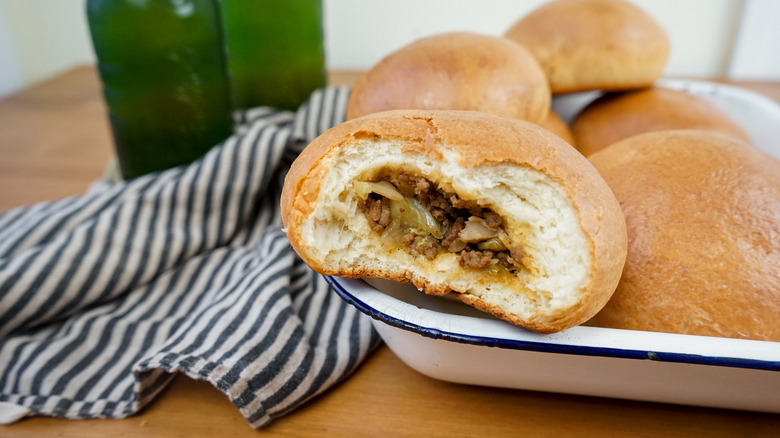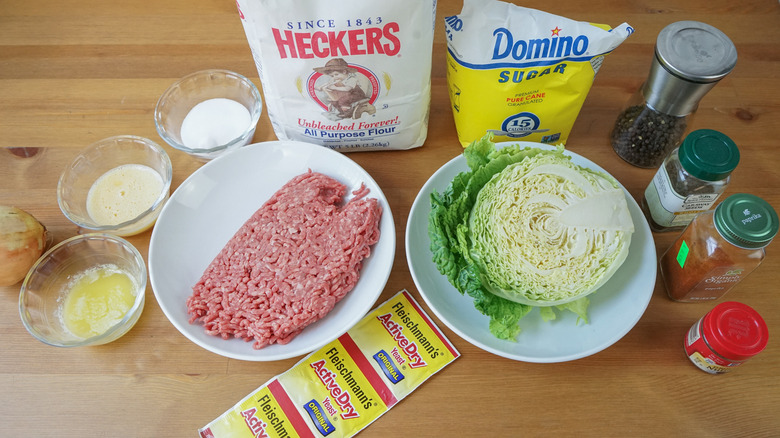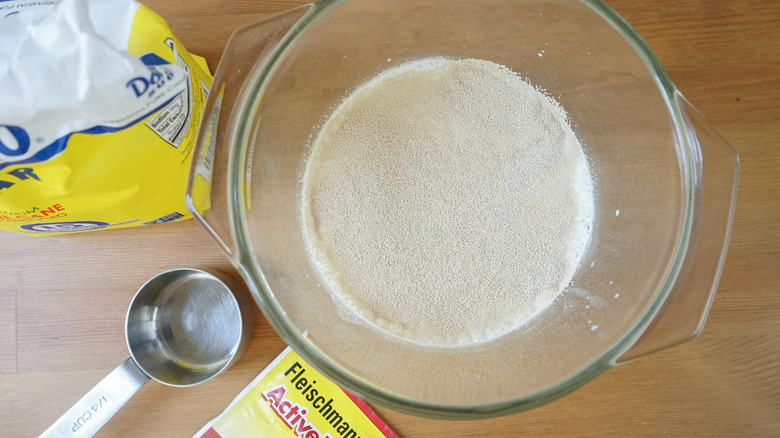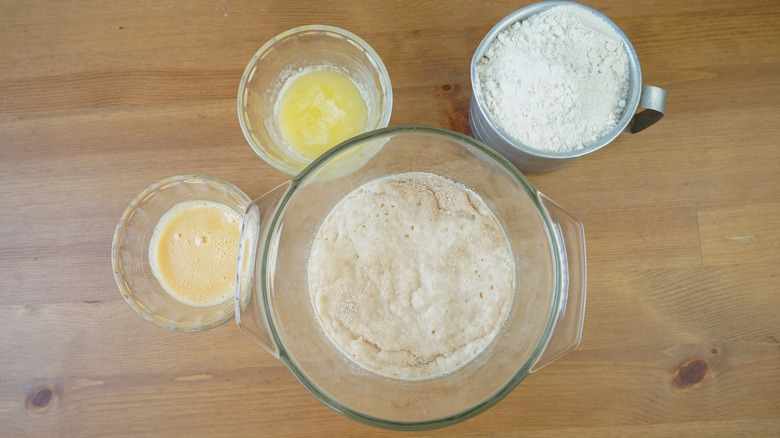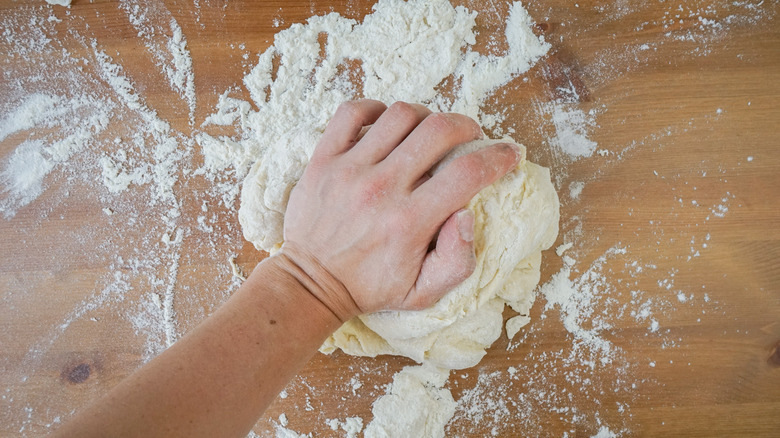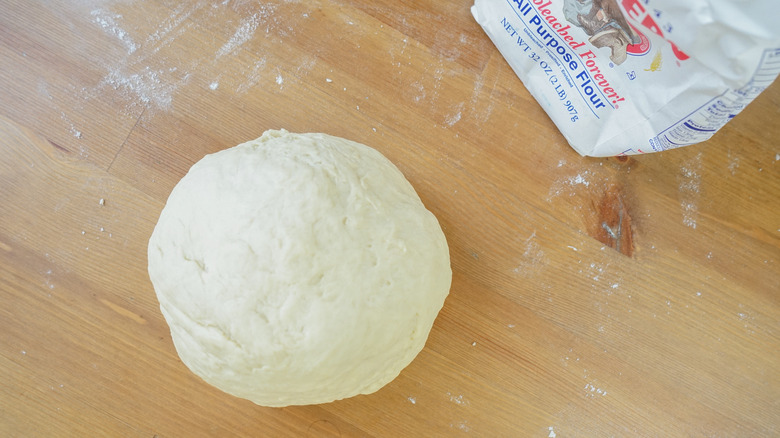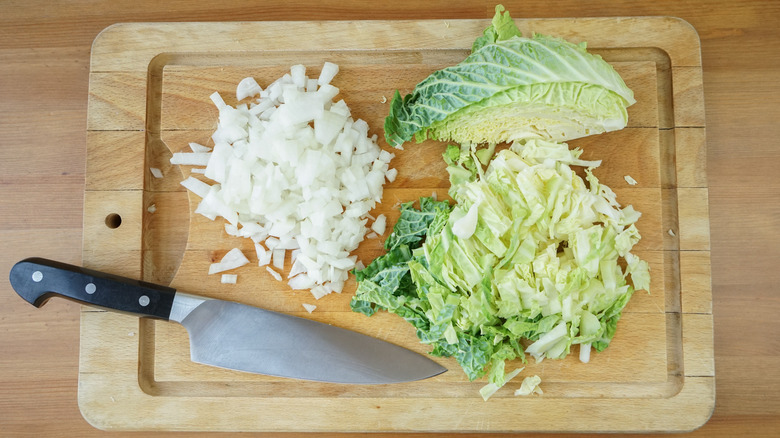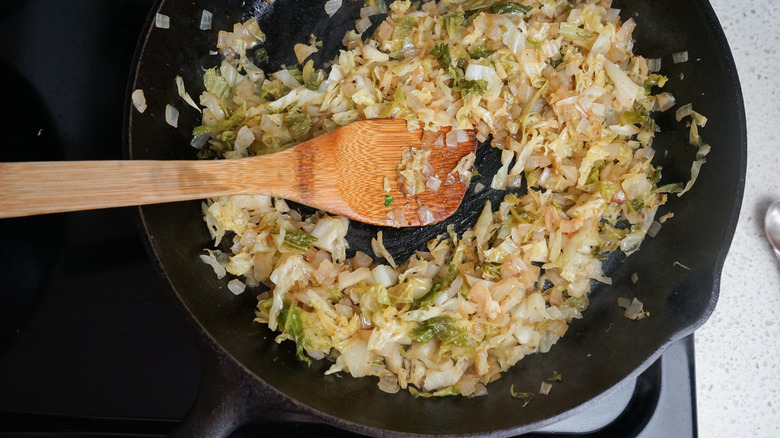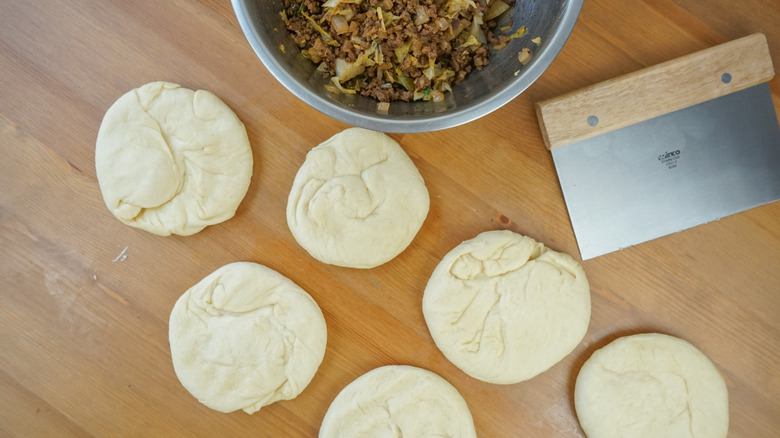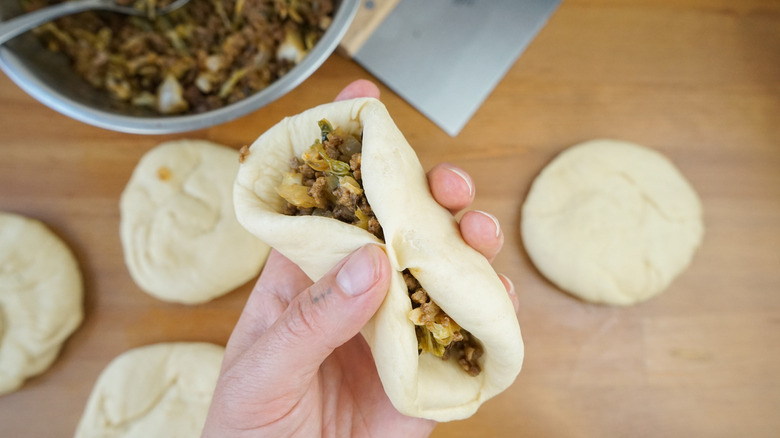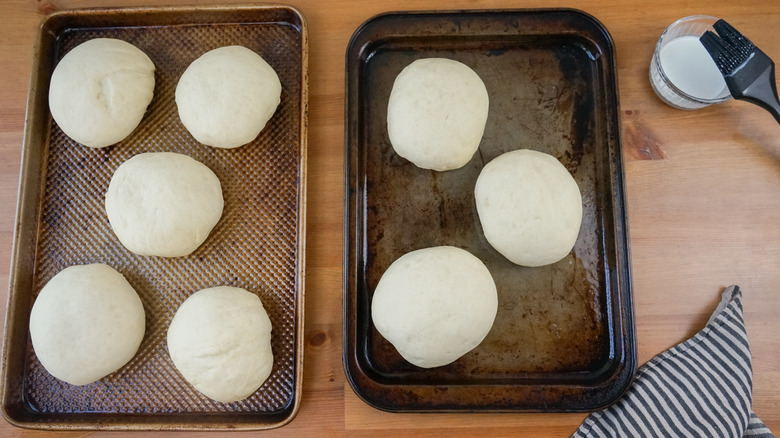Authentic German Bierocks Recipe
From pork baozi to empañadas, most every cuisine has some version of bread stuffed with savory filling — and German cuisine is no exception. Its stuffed rolls are called bierocks — and according to Lawrence Journal-World, they're descended from the Russian version of pierogi. They can be filled with almost anything you want, but for a truly German experience, meat and cabbage are the best, which is what recipe developer Sophie Putka chose for her authentic bierocks recipe.
This portable roll was adopted by Germans living in Russia and eventually made its way to the American Midwest, where it can still be found to this day. Bierocks aren't unusual in Kansas, and even spread to Nebraska where they morphed into something called a runza.
Bierocks are typically made with a mixture of ground beef, sauteed yellow onion, and cabbage or sauerkraut. This wholesome mixture gets tucked into a simple yeasted roll and then baked until warm and fluffy. For the best results, you'll need to set aside some time for the dough to rise twice and to make the filling –but trust us when we say that you'll forget all the work when you sink your teeth into a comforting bun with its hearty, protein-packed filling. You can even stick one in your pocket for later.
Gather your ingredients
For German bierocks, you'll need to first gather your ingredients. Begin with a packet of active dry yeast, sugar, some milk, plenty of all-purpose flour, melted butter, and an egg. For the filling, you'll need 12 ounces (¾ pounds) of ground beef, green cabbage, and a yellow onion.
From there, you can get creative with the seasonings. There's a misconception that food from Germany is bland and unseasoned, but this isn't always the case. We used some German staples to spice up the filling: caraway seeds, paprika, and nutmeg. A splash or red wine vinegar lends the mixture some tang and amps up the flavor of all the ingredients to bring them out of the more subdued bun.
Activate the yeast for a fluffy bun
Let's get one of the trickiest steps out of the way first. Yeast must be active for it to release the gases that make your bread puffy and soft. To activate the yeast, combine it with ¼ cup of sugar and a cup of warm milk and let it sit until it gets a bubbly, foamy layer. The key to this is getting milk to the right temperature — too hot and it could kill the yeast, too cool and the yeast could stay dormant. 100 F is a perfect temperature, which you can get by popping the milk into a microwave for about a minute.
Mix the warm milk with the sugar, sprinkle the yeast on top, and leave it to feast on the sugar for about 15 minutes.
Mix in the rest of the bierocks dough ingredients
Once the yeast has bubbled up successfully, it's time to add the flour, butter, and eggs. Egg and butter "enrich" the dough, giving it its subtle, rich flavor.
After whisking the yeast mixture, add in half of the flour immediately and mix it to incorporate. Then, mix in the butter and egg and continue to add in flour bit by bit — it might be harder to mix, but when most of it is in, you'll finally have what looks like a dough. You can even use your hands to fold in the flour, and then turn it onto a clean, dry surface with whatever flour is leftover to keep it from sticking.
Knead the German bierocks dough
Next is kneading that dough to form the gluten strands that will hold the rolls together and prevent them from crumbling apart (via Masterclass). Kneading also helps distribute the yeast evenly, and strengthens the dough so it can hold more air for maximum fluff.
Fold the dough down from the top and press down with your weight from the heel of one hand, rotating the dough 90 degrees with your other hand and folding it onto itself again until you have a semi-smooth, elastic texture. Of course, this isn't the only technique you can use — you can adapt it to whatever works for you.
Continue to knead the bierocks dough, then let it rise
Continue to fold and press for 10 to 15 minutes until an elastic dough forms. If the dough sticks to the surface, add a few tablespoons of flour and continue. If the dough isn't completely smooth after kneading for this long, don't be alarmed — some imperfection is fine for this purpose.
Place the dough in a greased bowl and turn to coat the dough. Set the dough aside in a dry, room temperature space (we like the oven — not turned on!) and let it rise until it's about doubled in size, or about an hour.
Prepare the German bierocks filling
While the dough rises, dice the onion finely and chop or shred the green cabbage into small pieces.
Set these aside and then place a skillet on high heat and add the ground beef. Brown it until it is cooked through and golden-brown. Lower the heat to medium and mix in the paprika, caraways seeds, and nutmeg. Then remove the beef from the pan and set it aside while you cook the vegetables.
Finish the German Bierocks filling
Now add some oil to the pan and add in the vegetables. Mix everything to combine, then keep the pan on medium heat and cover it for about 10 to 15 minutes. The moisture from the vegetables will cook them slowly, caramelizing them slightly for extra flavor.
Add the seasoned beef back into the pan, mix, and season with salt and pepper to taste. Pour in the red wine vinegar and cook it off to evaporate it for about two minutes before removing the filling from the heat and waiting for it to cool.
Divide the bierocks dough
Once the dough has doubled in size, punch it back down and, without mixing it more, divide it into eight even pieces on a clean surface. Try to roll each piece into a ball and, using a rolling pin or your hands, flatten it into a disk about six inches across.
The dough will be springy and may shrink a little. You can let the balls rest for a few minutes to reduce this problem, then flatten them again.
Fill the bierocks dough
Rest a flattened disk in the palm of your hand and spoon two tablespoons of cooled filling into the center. Then, firmly pinch the opposite sides of the dough together over the filling to fuse the dough together. Bring all the corners of the dough together to cover the filling, pinching and twisting as you go, so that if you release the dough, the ball stays closed. Try to let as little of the filling escape as possible — any oil that gets out will only make it harder to seal the dough together.
Let the bierocks rise, then bake them until golden
Next, set aside the filled bierocks on greased or lined baking sheets in a room temperature area again, leaving plenty of space between the rolls for them to double in size. This should take around 45 minutes, which you can use to clean up and preheat the oven.
Once doubled in size, brush each bierock lightly with milk and then place the trays in the oven for 20 minutes, turning the trays around halfway through to bake them evenly.
These are best served warm and go perfectly with — you guessed it — beer. And we can't imagine a better way to while away a summer night than a pile of pocket meat buns and some cold German brew.
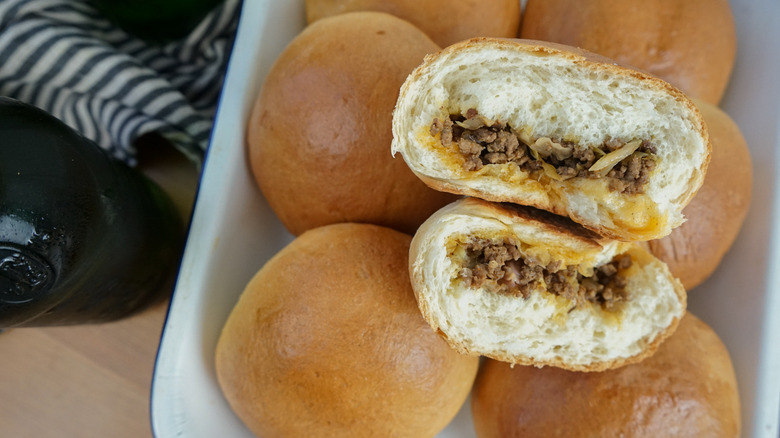
- 4 cups all-purpose flour, divided
- 1 packet active dry yeast
- ¼ cup sugar
- 1 cup whole milk, with extra for brushing
- 2 tablespoons melted butter, cooled
- 1 egg, beaten
- ¼ to ½ medium green cabbage
- 1 medium onion
- 12 ounces ground beef
- 1 teaspoon caraway seeds
- 2 teaspoons paprika
- ¼ teaspoon nutmeg
- 3 tablespoons vegetable oil
- Salt
- Pepper
- 4 tablespoons red wine vinegar
- Warm the milk to 100 F, about 1 minute in the microwave.
- Pour the milk into a bowl with the sugar and whisk to dissolve.
- Pour the active dry yeast on top of the milk and let it sit until a frothy layer has formed on top and most of the yeast has moistened, about 15 minutes.
- Whisk or mix in 2 cups of the flour.
- Whisk or mix in the cooled melted butter and egg.
- Working a little at a time, mix in the rest of the flour until most of it is incorporated.
- Turn out the dough and remaining flour onto a clean surface and knead it for 10 to 15 minutes.
- Grease the inside of a large bowl and place the dough inside, turning to coat it.
- Let it rise for an hour at room temperature, or until doubled in size.
- While the dough rises, dice the onion and shred or chop the cabbage into small pieces.
- Brown the ground beef on high heat and cook it through, breaking it up into small pieces, about 5 minutes.
- Lower the heat to medium and add the paprika, caraway seeds, and nutmeg. Remove the beef from the pan and set it aside.
- Add 3 tablespoons of vegetable oil to the pan and add the diced onion and cabbage.
- Mix to coat vegetables in oil and cover the pan, cooking for at least 10 to 15 minutes, until the cabbage and onion are golden and slightly caramelized.
- Add the beef back into the pan and mix on medium-high heat, seasoning with salt and pepper to taste.
- Add the red wine vinegar and cook for about 2 minutes, then set it aside too cool.
- Punch down the risen dough and divide it into eight even pieces.
- Roll the pieces into balls and flatten each one to create 6-inch circles.
- Fill each dough circle with 2 heaping tablespoons of filling.
- Gather the edges over the filling, pinching and twisting the dough firmly to seal.
- Set the bierocks on pre-greased baking sheets with space to rise, cover them loosely, and let them double in size, about 45 minutes.
- In the last 10 minutes, preheat the oven to 375 F.
- Brush the risen bierocks lightly with milk.
- Bake them for 20 minutes, rotating the pans once halfway through, until golden brown.
- Serve warm.
Nutrition
| Calories per Serving | 472 |
| Total Fat | 19.0 g |
| Saturated Fat | 6.3 g |
| Trans Fat | 0.7 g |
| Cholesterol | 60.9 mg |
| Total Carbohydrates | 58.0 g |
| Dietary Fiber | 2.6 g |
| Total Sugars | 8.7 g |
| Sodium | 419.9 mg |
| Protein | 16.1 g |
